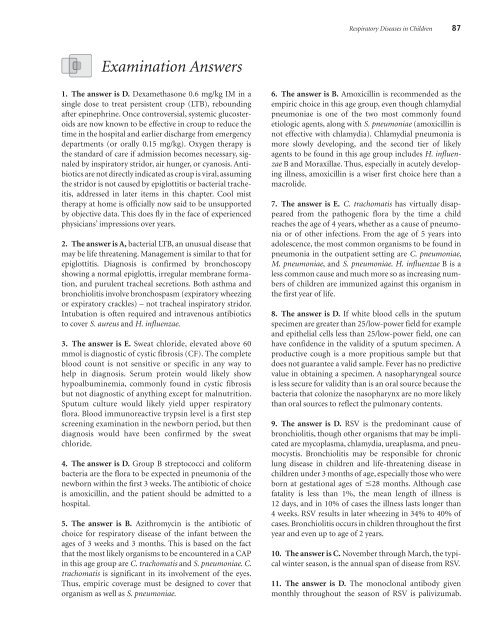NMS Q&A Family Medicine
NMS Q&A Family Medicine
NMS Q&A Family Medicine
- No tags were found...
Create successful ePaper yourself
Turn your PDF publications into a flip-book with our unique Google optimized e-Paper software.
Respiratory Diseases in Children 87Examination Answers1. The answer is D. Dexamethasone 0.6 mg/kg IM in asingle dose to treat persistent croup (LTB), reboundingafter epinephrine. Once controversial, systemic glucosteroidsare now known to be effective in croup to reduce thetime in the hospital and earlier discharge from emergencydepartments (or orally 0.15 mg/kg). Oxygen therapy isthe standard of care if admission becomes necessary, signaledby inspiratory stridor, air hunger, or cyanosis. Antibioticsare not directly indicated as croup is viral, assumingthe stridor is not caused by epiglottitis or bacterial tracheitis,addressed in later items in this chapter. Cool misttherapy at home is officially now said to be unsupportedby objective data. This does fly in the face of experiencedphysicians’ impressions over years.2. The answer is A, bacterial LTB, an unusual disease thatmay be life threatening. Management is similar to that forepiglottitis. Diagnosis is confirmed by bronchoscopyshowing a normal epiglottis, irregular membrane formation,and purulent tracheal secretions. Both asthma andbronchiolitis involve bronchospasm (expiratory wheezingor expiratory crackles) – not tracheal inspiratory stridor.Intubation is often required and intravenous antibioticsto cover S. aureus and H. influenzae .3. The answer is E. Sweat chloride, elevated above 60mmol is diagnostic of cystic fibrosis (CF). The completeblood count is not sensitive or specific in any way tohelp in diagnosis. Serum protein would likely showhypoalbuminemia, commonly found in cystic fibrosisbut not diagnostic of anything except for malnutrition.Sputum culture would likely yield upper respiratoryflora. Blood immunoreactive trypsin level is a first stepscreening examination in the newborn period, but thendiagnosis would have been confirmed by the sweatchloride.4. The answer is D. Group B streptococci and coliformbacteria are the flora to be expected in pneumonia of thenewborn within the first 3 weeks. The antibiotic of choiceis amoxicillin, and the patient should be admitted to ahospital.5. The answer is B. Azithromycin is the antibiotic ofchoice for respiratory disease of the infant between theages of 3 weeks and 3 months. This is based on the factthat the most likely organisms to be encountered in a CAPin this age group are C . trachomatis and S . pneumoniae . C .trachomatis is significant in its involvement of the eyes.Thus, empiric coverage must be designed to cover thatorganism as well as S . pneumoniae .6. The answer is B. Amoxicillin is recommended as theempiric choice in this age group, even though chlamydialpneumoniae is one of the two most commonly foundetiologic agents, along with S. pneumoniae (amoxicillin isnot effective with chlamydia). Chlamydial pneumonia ismore slowly developing, and the second tier of likelyagents to be found in this age group includes H. influenzaeB and Moraxillae. Thus, especially in acutely developingillness, amoxicillin is a wiser first choice here than amacrolide.7. The answer is E. C . trachomatis has virtually disappearedfrom the pathogenic flora by the time a childreaches the age of 4 years, whether as a cause of pneumoniaor of other infections. From the age of 5 years intoadolescence, the most common organisms to be found inpneumonia in the outpatient setting are C . pneumoniae ,M . pneumoniae , and S . pneumoniae . H . influenzae B is aless common cause and much more so as increasing numbersof children are immunized against this organism inthe first year of life.8. The answer is D. If white blood cells in the sputumspecimen are greater than 25/low-power field for exampleand epithelial cells less than 25/low-power field, one canhave confidence in the validity of a sputum specimen. Aproductive cough is a more propitious sample but thatdoes not guarantee a valid sample. Fever has no predictivevalue in obtaining a specimen. A nasopharyngeal sourceis less secure for validity than is an oral source because thebacteria that colonize the nasopharynx are no more likelythan oral sources to reflect the pulmonary contents.9. The answer is D. RSV is the predominant cause ofbronchiolitis, though other organisms that may be implicatedare mycoplasma, chlamydia, ureaplasma, and pneumocystis.Bronchiolitis may be responsible for chroniclung disease in children and life-threatening disease inchildren under 3 months of age, especially those who wereborn at gestational ages of 28 months. Although casefatality is less than 1%, the mean length of illness is12 days, and in 10% of cases the illness lasts longer than4 weeks. RSV results in later wheezing in 34% to 40% ofcases. Bronchiolitis occurs in children throughout the firstyear and even up to age of 2 years.10. The answer is C. November through March, the typicalwinter season, is the annual span of disease from RSV.11. The answer is D. The monoclonal antibody givenmonthly throughout the season of RSV is palivizumab.
















